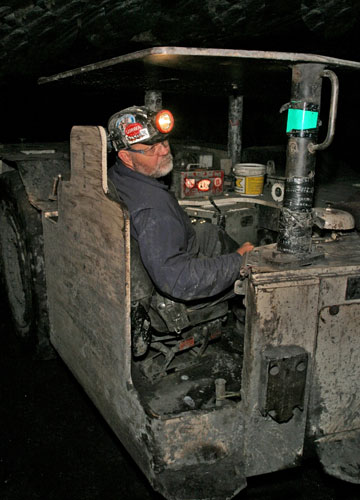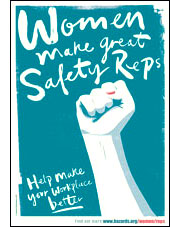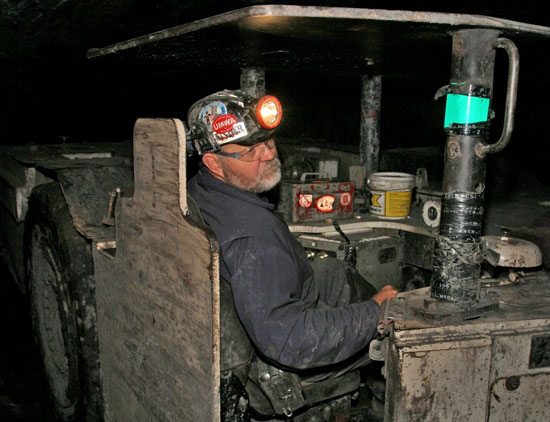

Don't die waiting
Hazards issue 115, July-September 2011
Workplace injuries would be slashed ‘at a stroke’ if all workplaces had a union health and safety rep. The claim comes from TUC head of safety Hugh Robertson, author the 2011 edition of TUC’s The Union Effect report. It notes “the new evidence shows that the union effect is just as strong as ever.”

GENDER AGENDA Unions work best when they represent everyone in the workplace. And they are at their most effective when grassroots union safety reps reflect the make-up of that workforce - and that means more women safety reps at work [more].
The TUC report is teeming with evidence to support the lifesaving union claims. A study of manual workers from Swansea University’s School of Business and Economics published in 2008 confirmed that workers in unionised workplaces were less likely to have a fatal injury. And a 2000 study from Cambridge University’s Judge Institute of Management Studies concluded the union protective effect extends to ill-health.
“The proportion of employees who are trade union members has a positive and significant association on both injury and illness rates,” the paper noted, adding “the arrangements associated with trade unions... lower the odds of injury and illness when compared with arrangements that merely inform employees of OHS issues.”
It’s an effect confirmed in a 2011 report on conditions in the notoriously hazardous US mining industry. The Stanford University law school study estimated traumatic injuries dropped by as much as a third in unionised mines, with the impact on fatalities substantially greater [See: Union mines are substantially safer].
For those unmoved by this impressive preservation of life and limb, the union safety effect is good for the bottom line too. The TUC report points to 2007 UK government report that concluded safety reps save society between £181m and £578m each year (based on 2004 prices) as a result of a lost time reduction from occupational injuries and work-related illnesses of between 286,000 and 616,000 days (Hazards 97).
GENUINE ACTION Public sector union UNISON is putting health and safety at the centre of a recruitment and organising drive. General secretary Dave Prentis says the union’s new ‘Organising for health and safety’ guide is part of a strategy “to turn UNISON into a genuinely organising union” [more].
TUC’s Hugh Robertson warns, however, that too many employers are denying union safety reps the time off they need, and only just over a quarter consult automatically with safety reps on a regular basis. The problem is much worse in workplaces that are not unionised, the TUC safety specialist said. He added: “The facts outlined in this report are indisputable. Trade union health and safety representatives prevent hundreds of thousands of injuries and illnesses every year and, at the same time save employers millions of pounds. Yet the positive effect this band of volunteers has goes almost totally unrecognised by employers and the government.”

MINE PROTECTION Miners in unionised US coal mines are far less likely to be killed or injured at work than miners in non-union operations - and this effect may be getting more pronounced, a new study has found.
According to Robertson, the new TUC briefing “shows that the most effective thing that the government could do to protect workers would be to enforce and strengthen the current consultation regulations. If every workplace had a union safety representative we could cut the number of fatalities and injuries at a stroke.”
Facts, though, won’t sway a government hell bent on reducing employment protection and workers’ rights, and determined to listen to the business lobby at the expense of listening to reason. That’s why TUC and individual unions are giving renewed emphasis to organising on health and safety.
This has two immediate benefits. Union organising around health and safety issues is the most effective way to deliver improvements and does not rely upon the goodwill of the employer or an increasingly rare appearance from a safety inspector. And union activity around health and safety not only protects the workforce, it strengths the union. It’s a copperbottomed union retention and recruitment tool.
Bid to get more women safety reps
 Unions work best when they represent everyone in the workplace. And they are at their most effective when grassroots union safety reps reflect the make-up of that workforce - and that means more women safety reps at work.
Unions work best when they represent everyone in the workplace. And they are at their most effective when grassroots union safety reps reflect the make-up of that workforce - and that means more women safety reps at work.
Safety enforcers have joined with unions to encourage more women to become workplace health and safety reps. ‘Help make your workplace safer’, a leaflet published by the Health and Safety Executive (HSE) and backed by rail safety regulator ORR, the TUC and individual unions, notes: “European research suggests that women are under-represented in the health and safety decision-making process. In particular, more women are needed to be safety representatives.”
The leaflet adds: “By representing your colleagues you’re playing vital role”, including making workplaces safer and “making sure that women’s views and experience of workplace health and safety are taken into account.”
And there are benefits for safety reps’ themselves, including new skills. It urges women interested in becoming safety reps to get in touch with their union.
Hazards women make great safety reps webpages.
UNISON pushes organisation on safety
Public sector union UNISON is putting health and safety at the centre of a recruitment and organising drive. General secretary Dave Prentis says the union’s new ‘Organising for health and safety’ guide is part of a strategy “to turn UNISON into a genuinely organising union.”
He adds: “There are few more important areas that can act as a vehicle for this than health and safety at work – particularly during the massive attacks by this Conservative led government on our public services.” According to Prentis, when budgets are cut, corners also tend to get cut on health and safety. “As always it is our union that stands between the excesses of the employer and our members. Achieving this means having an organised workplace where as many people as possible are members,” he says.
“Organising around health and safety issues cuts right to the core of what’s important for our members. Becoming an organising union means that as many people as possible take part in organising activities that helps to stand up for our members during these increasingly difficult times and continues the growth of our union.”
UNISON has a simple three step starter plan for organising around health and safety issues.
Visibility The clearest benefit of a unionised workplace is the presence of a union safety rep, UNISON states – but that rep needs to be trained, receiving ongoing support from the union and must “make their presence visible to their members. Emails, newsletters and noticeboards are all great places to publicise health and safety achievements.” It says unions should make sure management does not hog the credit for improvements pushed through by the union, but should instead make sure members know about the union contribution. “This will demonstrate that UNISON is active on health and safety and may help to recruit new members,” the guide notes.
Mapping Tot up the resources available to the union. Use a mapping exercise to see the density of members and non-members in an employer’s different locations, as well as the number and locations of safety reps.
Identify the key issues According to the UNISON guide, exploring the major health and safety concerns in the workplace “will serve both as an audit of the current situation as well as highlight areas that need further or altered representation. Addressing these issues will become a primary recruitment tool.” It recommends assembling an “organising team” – the workplace health and safety reps aided by interested branch officials, shop stewards and others. “Remember, however, that the aim is to get workers organised and active, rather than ‘leave it to the union’,” the guide reminds safety reps.
Non-union areas Where the union doesn’t have a presence, more groundwork is required. “Workers know the most about their own working conditions so the best thing to do is ask and listen,” the UNISON guide notes. “While doing this you should also begin to identify key individuals who can be your primary contacts as well as the basis of an organising committee. These contacts will be your largest asset.” It urges reps to “give them your time and ensure they are supported, which should include regular one-to-one contact.”
Back to main story
Union mines are substantially safer

Miners in unionised US coal mines are far less likely to be killed or injured at work than miners in non-union operations - and this effect may be getting more pronounced, a new study has found. The independent Stanford University research, funded by the US government’s National Institute for Occupational Safety and Health (NIOSH), found a dramatic decline in injuries and fatalities at union mines.
The comprehensive study, conducted by law professor Alison D Morantz of Stanford Law School, looked at coal mine fatality and injury statistics from 1993 to 2008. She concluded: “My best estimates imply that overall, unionisation predicts about a 17-33 per cent drop in traumatic injuries and about a 33-72 per cent drop in fatalities.”
Mine Workers (UMWA) president Cecil Roberts says the study “quantifies the profound differences in safety underground coal miners experience when working union versus working non-union.” The study’s findings suggest that the union safety effect may have “intensified”.
Professor Morantz concludes: “Unionisation’s attenuating effect on the predicted frequency of traumatic injuries seems to have grown since the mid-1990s.” This coincides with the development by UMWA of a more comprehensive safety programme and expanded training for union safety experts at the local and national levels.
UMWA’s Cecil Roberts says that while the study shows union mines are safer, tragedies can still happen, such as the 2001 explosion at the Jim Walters #5 mine in Brookwood, Alabama, that killed 13 miners. “We in the UMWA learned hard lessons in that tragedy and others that preceded it,” he said. “We took steps to provide better protection for our members, and this study demonstrates that those steps are working. We will continue to work as hard as we can to keep the mines where UMWA members work the safest in the world.”
Alison D. Morantz. Coal mine safety: Do unions make a difference?, Stanford Law and Economics Olin Working Paper No. 413, Stanford Law School, 27 May 2011.
Selected references
The Union Effect - How unions make a difference to health and safety. TUC worker involvement webpages. Stronger Unions.
Alison D. Morantz. Coal mine safety: Do unions make a difference?, Stanford Law and Economics Olin Working Paper No. 413, Stanford Law School, 27 May 2011 [pdf]. Stanford webpages on Coal mine safety: Do unions make a difference?.
Suzanne Grazier, Compensating wage differentials for risk of death in Great Britain: an examination of the trade union and health and safety committee impact,
School of Business and Economics, Swansea University, 2007.
A Robinson and Clive Smallman, The healthy workplace? Judge Business School, University of Cambridge, 2000.
Don't die waiting
Bid to get more women reps more
UNISON pushes organisation on safety more
Union mines are substantially safer more
Hazards webpages
Union effect • Deadly business
Mine photos, courtesy Earl Dotter